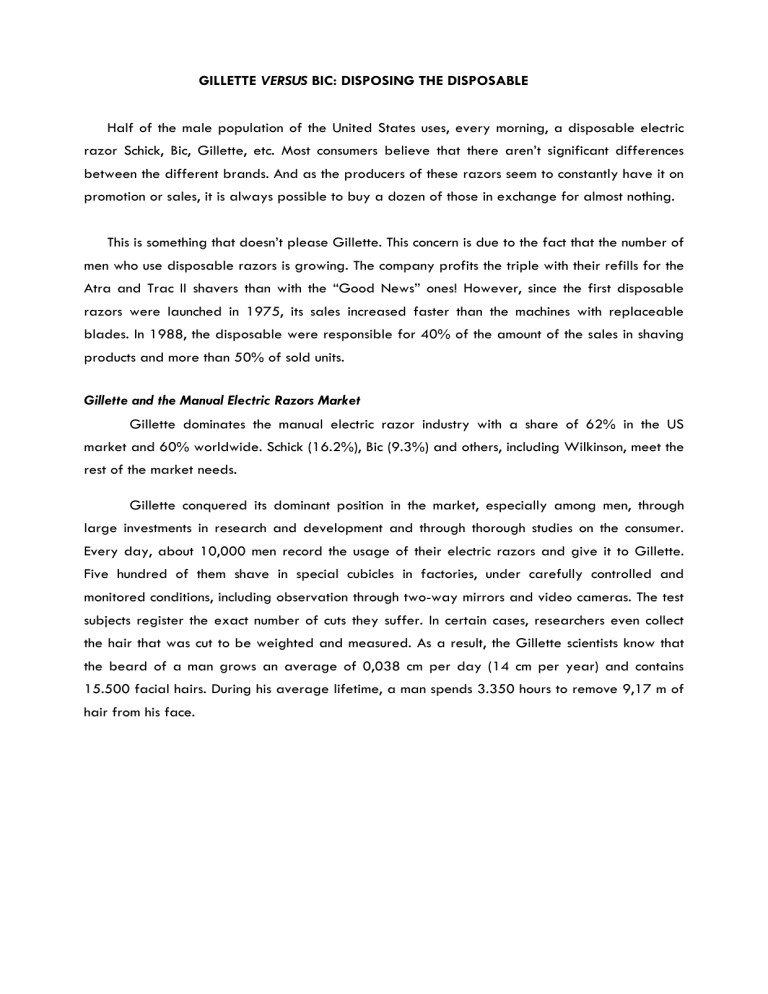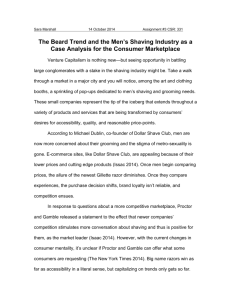
GILLETTE VERSUS BIC: DISPOSING THE DISPOSABLE Half of the male population of the United States uses, every morning, a disposable electric razor Schick, Bic, Gillette, etc. Most consumers believe that there aren’t significant differences between the different brands. And as the producers of these razors seem to constantly have it on promotion or sales, it is always possible to buy a dozen of those in exchange for almost nothing. This is something that doesn’t please Gillette. This concern is due to the fact that the number of men who use disposable razors is growing. The company profits the triple with their refills for the Atra and Trac II shavers than with the “Good News” ones! However, since the first disposable razors were launched in 1975, its sales increased faster than the machines with replaceable blades. In 1988, the disposable were responsible for 40% of the amount of the sales in shaving products and more than 50% of sold units. Gillette and the Manual Electric Razors Market Gillette dominates the manual electric razor industry with a share of 62% in the US market and 60% worldwide. Schick (16.2%), Bic (9.3%) and others, including Wilkinson, meet the rest of the market needs. Gillette conquered its dominant position in the market, especially among men, through large investments in research and development and through thorough studies on the consumer. Every day, about 10,000 men record the usage of their electric razors and give it to Gillette. Five hundred of them shave in special cubicles in factories, under carefully controlled and monitored conditions, including observation through two-way mirrors and video cameras. The test subjects register the exact number of cuts they suffer. In certain cases, researchers even collect the hair that was cut to be weighted and measured. As a result, the Gillette scientists know that the beard of a man grows an average of 0,038 cm per day (14 cm per year) and contains 15.500 facial hairs. During his average lifetime, a man spends 3.350 hours to remove 9,17 m of hair from his face. With such knowledge on shaving and people that shave, Gillette can stay ahead of its competitors. When the competitors adjust to a certain system of electric razors, Gillette introduces a new breakthrough. In 1971, Gillette introduced Trac II, the first electric razor to have two parallel blades assembled in a rechargeable cartridge. In 1977, after an investment of $ 8 million in R & D, the company introduced Atra, with a cartridge containing two identical blades that adapts to the person's face contours. In 1985, Gillette launched the Atra Plus, which contains a lubricating strip added to Atra´s cartridge, in order to make shaving even softer. Although the company's founder, King Gillette, was interested in developing a disposable product, the marketing strategy of Gillette has focused on developing products that use replaceable blades into a permanent body. Gillette seeks to involve its shavers in an aura of class and superior performance. Promoting new captive systems, in which a given cartridge fits only a certain shaver, Gillette raises prices and the profit margin at every new technological innovation. Thus, since the cartridges for Atra don´t fit the Trac II system, consumers need to buy a new device so they can use the Atra blades where a new system was introduced. Gillette never bothered with the lowest layer of the market: cheap blades, of owned brands. They believe that men seeking status always buy a "class" product. Most men take shaving very seriously and its appearance is considered as a matter of some importance. Thus, most men will not seek a less expensive and more common brand if, for an amount slightly higher, they can get Gillette products that would provide the best shave. Bic and the Rise of the Disposable The rapid rise of disposable electric razors was a threat to the vision that Gillette had on the shaving philosophy of men. Bic introduced a disposable shaver, for the first time, in 1975, in Europe and, the following year, in Canada. The next market to be hit would be the United States. Gillette launched the first disposable device in the US market in 1976 - the Good News!, made of blue plastic, which used the Trac II system blade. Despite its defensive reaction, Gillette predicted that the disposable device would be used only on travels, changing rooms or in the case the user forgets the traditional device. The company believed that the disposable devices could never get more than 7% of the market. Marcel Bich, founder of Bic and the force behind the challenge set to Gillette, believed in the disposable. Bich enriched creating the pen. His strategy was to transform status products into current products. Often, a product has a status because it is difficult to produce and must be sold for a high price. But, if a producer develops methods to mass produce the product at a low cost - albeit with little loss of its functional qualities will cause it to lose its status and charm. Consumers won’t feel embarrassed for buying it and being seen using a cheaper version of the product. Thus, Bic creates its brands, takes away its glamor, makes a wide distribution and sells it cheap. Its marketing strategy is simple: maximum service, minimum price. Given its strategy, Bic doesn’t do market research with consumers to study the thoroughness of the shaving technology, nor does it have an electronic microscope to measure the beard facial hairs. Bic’s electric razor (which costs 25 US cents or less) has only one blade mounted on a short and hollow body. Still, Bic’s disposable shaver is the most serious challenge Gillette has ever faced. In 1988, Bic’s shaving products reached 52 million dollars in sales, with a net income of 9,4 million and the ownership of a share of 22,4% of the disposable market. Gillette Versus Bic In their separate efforts to develop disposables, Gillette and Bic have had previous confrontations before this, in other areas. In the 50’s, they fought for market share in the pen market. The Gillette products Paper Mate, however, couldn’t match BIC’s mass advertisement and discounts. The two companies competed again in the 70s, for the disposable lighters market, which again created mass consumption products from goods that were, previously, considered expensive and prestigious. While Gillette has had a better performance in disposable lighters than in pens, Bic lighters won a dominant market share. However, in the latest confrontation, the Good News! Gillette brand still wins with the largest share (58%) in the disposable electric razors market, but the victory is somehow bitter. The problem? Good News! sells itself for much less than any of the old Gillette products. The key competition in the current homogeneous products is the price. To compete with Bic’s shaver, which costs 25 cents, and other disposable ones, Gillette has to sell Good News for a much lower price than the retail price of an Atra or Trac II cartridge. As many users of Atra or Trac II electric razors concluded, a Gillette double bladed cartridge costs 56 cents and exactly the same blade mounted in a complete unit can be purchased for only 25 cents. Good News! not only generates less revenue per blade sold, but also costs more, since Gillette must provide both the blade and the body of the device. Each time the Good News! market share increases, Gillette loses millions of dollars in sales and profits of their Atra and Trac II products. The Shaving Psychology The battle between Bic and Gillette is more than a simple dispute in order to find out what types of electric razors consumers wish to use. It symbolizes a disagreement around one of the most enduring male rituals. Before King Gillette have invented the Gillette blade and its shaver, men considered shaving a tedious, difficult, time-consuming and often hurtful task. That is why they would do it only twice a week. Only the wealthiest people could have access to a barber’s daily services. Gillette trademarked its electric razor in 1904, but the product only gained wider acceptance in the First World War. The company had the bright idea of giving a free shaver to every soldier. This way, millions of men who were entering the age to shave created the daily habit of shaving. The morning ritual of shaving continues to occupy a prominent place in the lives of men, asserting masculinity. The first shaving remains a rite of passage from adolescence to maturity. Research by psychologists in New York revealed that, while men claim that shaving is uncomfortable, 97% of the inquired ones wouldn’t want to use a cream, if one was created, that would permanently remove facial hair. In the past, Gillette introduced a new shaver that existed in dense, medium and light versions. Almost no one bought the version for sparse beard, because most men didn’t want to publicly acknowledge the modest growth of their beard. Even though shaving currently requires less skill and involves less risks than before, many men still believe that shaving is a serious matter. A typical man considers his electric razor an important article of personal use, a kind of extension of its personality, as are examples of a luxury pen, a lighter, a folder for documents or a set of golf clubs. The Challenge of Gillette For over 80 years the perception that Gillette had about the market of beard products was considered perfect. Its products had a market share of 62% and its technology and marketing philosophy controlled the entire industry. Gillette managed to successfully keep the masculine appearance of the electric razor as well as its status as a personal identification item. Now, however, millions of men shave daily with small plastic devices, simple, without any emotional appeal and that cost 25 cents - an act that seems to be the absolute denial of the shaving ritual. Therefore, Good News! brings bad news for Gillette. Gillette must find a way to dispose of the disposables. GROUP ASSIGNMENT QUESTIONS: 1. “(…)many men still believe that shaving is a serious matter (…) A typical man considers his electric razor an important article of personal use, a kind of extension of its personality”. Comment the text above taking into consideration the self concept theories. 2. Examine the decision making types of shavers. What would be the differences between Gillette Atra (non-disposable) vs BIC disposable? 3. Describe the hierarchy of effects behind the purchase of Gillette Atra (non-disposable) vs BIC disposable? 4. What could Gillette do to encourage men to use non-disposable shavers? Discuss it under the perspective of how consumers form Attitudes.





